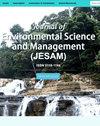Preparation and Characterization of Activated Carbon Derived from Antidesma bunius L. in Methylene Blue Removal from Wastewater
IF 0.3
4区 环境科学与生态学
Q4 ENVIRONMENTAL SCIENCES
Journal of Environmental Science and Management
Pub Date : 2020-12-27
DOI:10.47125/jesam/2020_sp1/03
引用次数: 3
Abstract
This study investigated the effect of contact time and methylene blue (MB) solution concentration on the adsorption capacity of granulated activated carbon derived from bignay (Antidesma bunius L.) seeds. The raw bignay seeds were subjected to physical activation via oven drying at 120°C and carbonization at 500°C for 30 min. The maximum adsorption capacity of both powdered and granulated activated carbon were determined. The alkyl functional groups of Bignay activated carbon (BAC) were determined using Fourier transform infrared (FTIR) analysis and the surface morphology and composition of the BAC were analyzed using scanning electron microscopy-energy dispersive x-ray (SEM-EDX). Langmuir, Freundlich, Temkin, and Dubinin-Radushkevich isotherm models were used to analyze the adsorption of isotherm BAC. But the data best fitted with the Freundlich isotherm. The mean energy of the adsorption showed that the adsorption of MB by BAC was physical adsorption implying that MB molecules were trapped in the pores of the BAC. The maximum adsorption capacity was 1.60 mg g-1. The rate of adsorption was used to determine if the process is physisorption or chemisorption using pseudo-first order and pseudo-second order adsorption kinetics. The data showed best fit for pseudo-second order ,suggesting that the reaction depends on the concentration of both reactants布氏Antidesma bunius L.活性炭的制备及性能研究
研究了接触时间和亚甲基蓝(MB)溶液浓度对大白菜种子颗粒活性炭吸附能力的影响。通过120℃烘箱干燥和500℃炭化30 min对粗麻黄籽进行物理活化,测定粉状活性炭和粒状活性炭的最大吸附量。采用傅里叶变换红外(FTIR)分析确定了Bignay活性炭(BAC)的烷基官能团,并利用扫描电镜-能量色散x射线(SEM-EDX)分析了BAC的表面形貌和组成。采用Langmuir、Freundlich、Temkin和Dubinin-Radushkevich等温线模型分析等温线BAC的吸附。但数据最符合Freundlich等温线。平均吸附能表明BAC对MB的吸附为物理吸附,表明MB分子被吸附在BAC的孔隙中。最大吸附量为1.60 mg g-1。采用准一级和准二级吸附动力学,以吸附速率确定吸附过程是物理吸附还是化学吸附。结果表明,该反应与两种反应物的浓度有关
本文章由计算机程序翻译,如有差异,请以英文原文为准。
求助全文
约1分钟内获得全文
求助全文
来源期刊

Journal of Environmental Science and Management
ENVIRONMENTAL SCIENCES-
CiteScore
0.90
自引率
0.00%
发文量
10
审稿时长
2 months
期刊介绍:
The Journal of Environmental Science and Management (JESAM) is an international scientific journal produced semi-annually by the University of the Philippines Los Baños (UPLB).
JESAM gives particular premium to manuscript submissions that employ integrated methods resulting to analyses that provide new insights in environmental science, particularly in the areas of:
environmental planning and management;
protected areas development, planning, and management;
community-based resources management;
environmental chemistry and toxicology;
environmental restoration;
social theory and environment; and
environmental security and management.
 求助内容:
求助内容: 应助结果提醒方式:
应助结果提醒方式:


